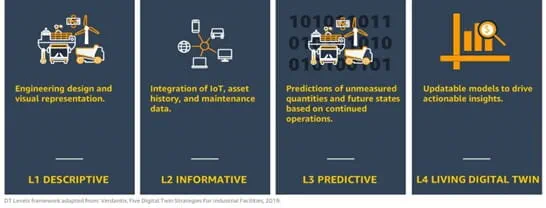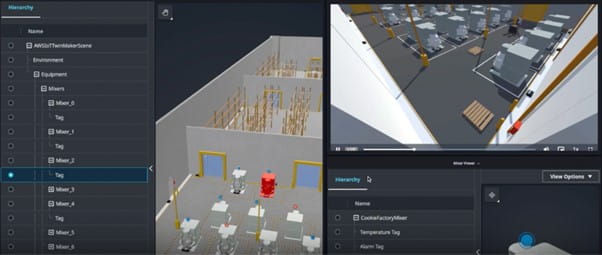Building and Using Digital Twins with AWS Cloud
- December 15, 2022

Digital transformation brings changes across industries, including the manufacturing sector. Client expectations are changing, forcing organizations to bring customer-centric experiences for competitive advantages. Technology modernization and data management are crucial elements.
Digital Twin technologies are a fast-growing and exciting concept of Industry 4.0. In the 2022 Gartner® Emerging Technologies: Revenue Opportunity Projection of Digital Twins* report analysts Alfonso Velosa and Peter Middleton estimate that the Digital Twin market will reach $150 billion in revenue by 2030. They continue, “By 2027, 70% of the top 20 global consumer goods companies will design digital twins of their consumers as part of their customer experience (CX) strategy.” It’s clear that Digital Twin technologies are full promises and offers some really exciting opportunities.
What is a Digital Twin?
A digital twin is a computer program using real-world data to create simulations that can predict how a product or process will perform. It is a digital representation of a physical object, process or service – for example, a jet engine, windmill or a whole factory.
Organizations are generating and collecting a growing amount of data on their processes, equipment, and manufacturing facilities due to technological advances in cloud computing, artificial intelligence (AI) and the Internet of Things (IoT). Digital twin technology integrates with IoT (Industry 4.0), AI, and data analytics to enhance the output and provide meaningful insights. This technology allows you to monitor the performance of an asset, identify potential faults, and make better-informed decisions about maintenance and lifecycle.
The Four Elements of a Digital Twin
A Digital Twin has four critical elements
- The physical system – The physical system is a physical entity like an industrial or biological, chemical, or ecological system.
- The digital representation – The digital representation is a model emulating the physical system's behavior like a simulation where the model can give an output based on a provided input.
- The connectivity between the physical and digital systems – The connectivity aspect should update the digital model with data inputs from the physical model using sensors, for example.
- The business outcome
Model validation is a process that confirms that the model actually achieves its intended purpose. A validated model provides a snapshot of the behavior of an object at a specific moment. The advantage of using a validated model in a digital twin is that it extends the use of that model to timescales over which the object and its behavior will change significantly.

Figure 1: Digital Twin (Image courtesy of AWS)
How Does Amazon Web Services (AWS) Help with Digital Twin Technology?
Using AWS IoT TwinMaker, you can create digital twins of real-world systems that help you optimize operations and performance. There are various tools in AWS IoT TwinMaker that enable digital replication of factories, manufacturing facilities, production lines and industrial equipment.
The in-built tools help import existing 3D models, such as computer-aided design (CAD) and building information modeling (BIM) files, into AWS IoT TwinMaker to create 3D visualizations of chosen systems.
AWS IoT TwinMaker is helpful in various use cases. Depending on the use case, you can do the following:
- Optimize building operations
- Accelerate production output
- Improve equipment performance
- Find and address process anomalies
- Monitor and enhance building conditions
Digital Twin Use Cases – How to Choose the Solution You Need?
Digital twin technology can have challenges when clients must choose a solution for their requirements. AWS helps customers better understand the solution by categorizing the use cases.
Digital Twin Leveling Index
The Digital Twin leveling index has 4 levels:
- Descriptive
- Informative
- Predictive
- Living
Levels 1 to 3 apply to different use cases with varying levels of complexity, where each level has its business value. Let’s consider an autonomous self-driving car. L0 is manual driving, L1 is cruise control, and L5 is a fully autonomous self-driving car (with no steering wheel).
In the next section, you can see details on each of these indexes so you can understand their differences.

Figure 2: Digital Twin leveling Index (Image courtesy of AWS)
Level 1: Descriptive
Level 1, Descriptive, focuses on the engineering design and the visual representation of the physical system, like its structure. It can include a 2D engineering diagram, engineering analysis, or a complex high-fidelity 3D/AR/VR model. The core purpose is to provide a good understanding of the design of the physical system and its components.
The core AWS services that may help you to build a Digital Twin Level1 in AWS: are AWS Batch, AWS ParallelCluster, Amazon FSx For Lustre, and compute-optimized Amazon Elastic Compute Cloud (Amazon EC2) instances for running the simulations.
Level 2: Informative
Level 2, Informative, focuses on connectivity by integrating IoT sensors and maintenance data from the physical system. Informative 2D dashboards or a 3D contextual visualization help to understand the physical system's current condition, and analytics can help trigger warnings.
Typical use cases in the industrial sector include domains of IoT and enterprise asset management (EAM) or enterprise resource planning (ERP) systems that show information on asset configuration, maintenance history, and upcoming work.
The core AWS services needed: are AWS IoT TwinMaker, AWS IoT Core, AWS IoT Greengrass, AWS IoT SiteWise, AWS IoT Analytics, Amazon QuickSight, Amazon Textract, Amazon Rekognition, Amazon DynamoDB, and Amazon S3.
Level 3: Predictive
Level 3, Predictive, focuses on predictions of unmeasured quantities like virtual sensors and using predictive models. These help in understanding the future states under continued operations where the future behavior is the same as past behavior. Typical use cases include operational planning and predictive maintenance regarding Asset Performance Management.
The core AWS services needed: Amazon Lookout for Equipment, Amazon Lookout for Vision, Amazon Monitron, AWS Panorama, AWS High-Performance Computing (HPC) related services, Amazon SageMaker, AWS Deep Learning AMIs, and AWS Deep Learning Containers.
Level 4: Living
Level 4, Living, focuses on updatable models to drive actionable insights at the individual entity level or the fleet level. The significant difference between L4 and L3 is that the digital model gets updates based on data from the physical entity. The core AWS services needed will be Amazon EC2, Amazon S3, Amazon DynamoDB, AWS Lambda, Amazon SageMaker, AWS Deep Learning AMIs, and AWS Deep Learning Containers.
Categorizing Your Use Case
In the next section, I’ll illustrate examples of L1 Descriptive, L2 Informative, L3 Predictive, and L4 Living Digital Twins. You can see how best you can categorize your requirements to L1-L4 Leveling Index and discover how you can leverage AWS to help you gain the advantage.
L1 Descriptive digital twins
L1 Digital Twin emphasizes describing the physical system. This exercise includes details like initial business case analysis, requirements for the detailed engineering design, and 3D visualizations. The Digital Twin Leveling Index L1 describes the structure, components, and relationship within the physical system.
In the example of an electric vehicle (EV), the L1 Descriptive Digital Twin solution will have information on data, models, technologies, AWS services and business processes. Describing details for the L1 Descriptive Digital Twins descriptions can cover areas like (1) asset models, (2) engineering design, and (3) immersive virtual reality environments.
For example, in the case of asset modeling for an EV, the diagram can show the vehicle's significant systems, subsystems and components. The information describes the structure of the Digital Twin, represented as an entity model in a graph database such as Amazon Neptune, You can further query and aggregate data from various sources using a knowledge graph. AWS IoT TwinMaker service makes creating digital twins of real-world systems easy. It allows you to connect to different data sources to create, update, and query the asset entity model.
An L1 Descriptive example can show engineering description during the design of the vehicle by the OEM. Besides, these engineering designs can help in modeling tire-road contact interaction when the vehicle is driven over simulated uneven terrain. Based on the inputs, the model provides the vehicle suspension deflection.
In the same way, one can capture an Immersive Extended Reality Experience. Creating an Immersive Extended Reality Experience involves applying extended reality (XR) technologies, like high fidelity 3D, immersive virtual reality (VR), and interactive augmented reality (AR). It gives users a real-life vehicle experience simulation and interactive virtual experience, which helps during the customer engagement process.
L2 Informative Use Case: CookieFactory Digital Twin
The 2nd level focuses on being informative. It will describe the state of a physical system. Connections to data streams from the physical system visualize the current state. Rich visualizations are possible with the help of dashboards or in the form of full 3D immersive environments. Dashboards show data such as configuration, maintenance history, and upcoming work orders. It is feasible in industries using IoT and Asset Management, having integrations with enterprise asset management (EAM) or enterprise resource planning (ERP) systems.
Example use cases are (1) real-time monitoring of a single vehicle with simple alarms, (2) real-time monitoring of a fleet of vehicles, and (3) battery degradation monitoring. Using the AWS IoT TwinMaker service, one can connect the 3D representation of the vehicle. Triggers of alarms and notifications on various events like battery charge falling below a preset value are examples. Tools like Grafana for dashboards and others include AWS IoT SiteWise and Amazon Timestream.
Below are details on a CookieFactory Digital Twin. This demo walks you through building a digital twin application using AWS IoT TwinMaker. The demo contains a CookieFactory sample that simulates a cookie factory so that we can explore the features of AWS IoT TwinMaker. CookieFactory demo code is in GitHub repo
The dashboard runs in Grafana, where you can interact with the sample CookieFactory, a digital twin.


Figure 3: CookieFactory Grafana dashboard
L3 Predictive Use Case: Pump Station Digital Twin
The L3 Predictive Digital Twin focuses on modeling the behavior of the physical system. It makes predictions of future states under continued operations, assuming future behavior is the same as the past. Predictive models rely on machine learning or principles like physics stimulation or a hybrid. Typical use cases for L3 predictive digital twin are virtual sensors, anomaly detection and imminent failure predictions over concise time horizons.
Handling equipment failure can be optimal if one can predict failure or maintenance, leading to reduced machine downtime. The L3 Predictive Digital Twin is suitable if you need to monitor, predict and get alerts on potential machine failures. Technical challenges with condition-based monitoring are collecting data from different sensors and storing and cataloging them. Using AWS IoT SiteWise helps to resolve these challenges. It helps collect, store, organize, and monitor data from various industrial equipment at scale. Building and maintaining Machine Learning (ML) models are complex; you can use Amazon Lookout for Equipment here. It automates the development of multivariate ML models for complex industrial assets and achieves near-continuous monitoring quickly.
You can explore the L3 Predictive use case: Pump station Digital Twin in detail in another blog post here.
L4 Living Use Case: Electric Vehicle
An L4 Living Digital Twin emphasizes modeling the physical system's behavior as it changes over time using real-world data to update the model parameters. The difference in the L3 Predictive Digital Twin is that the operational data is used as input to a static pre-trained model to obtain the response output.
Some examples of real-world operational data in L4 Living Digital Twin are continuous data (time series), sensor-based measurements, and visual inspection data/streaming video-based observations.
There is a two-step process before production deployment.
Step 1: You must build the model using first principles ("physics-based"), historical operational data, or hybrid modeling techniques.
Step 2: The second step involves performing a sensitivity analysis of the model parameters, where you select which parameters will be updatable.
You follow that up by confirming that the selected subset captures all the variations in the real-world data. Later, using a probabilistic calibration algorithm, one must calibrate the model's parameter before deploying it in production.
In production, the deployed model predicts the measured values and compares them against the actual measured values to calculate the error term. There will be no adjustments if the error is less than a preset threshold. The model proceeds to predict the next measured values.
If the error term is larger than the threshold, then the probabilistic Bayesian calibration algorithm will update the model parameters to reflect the latest data observations. This capability to update is the reason for calling the L4 Digital Twin "living."
You can explore predictive modeling examples at the following links
- AWS Framework GitHub repo: https://github.com/aws-samples/aws-do-pm
- Youtube: https://www.youtube.com/watch?v=4i6issYj_Zw
Conclusion
AWS Digital Twins can transform the industrial sector. The data collected from a digital twin delivers actionable insights into the complete lifecycle of processes. It provides the tools to optimize your workflows, optimize the supply chain, manage product quality, and spot any errors before they happen.
We encourage you to map your real-world organizational use cases to the L1-L4 Digital Twin leveling index to determine your category. AWS offers various tools for each category, so your Digital Twin is up and running efficiently and delivers successful results.
Let us know what you think of Digtial Twins on social media (Facebook, Twitter, Instagram and LinkedIn). And if you liked this post, be sure to sign up for our blog newsletter: click here and scroll to the bottom of the page.
* Gartner, Inc., “Emerging Technologies: Revenue Opportunity Projection of Digital Twins,” by Alfonso Velosa and Peter Middleton, Published on 16 February 2022 (Doc ID G00755100) https://www.gartner.com/en/documents/4011590
GARTNER is a registered trademark and service mark of Gartner, Inc. and/or its affiliates in the U.S. and internationally and is used herein with permission. All rights reserved.
Subscribe to our blog





